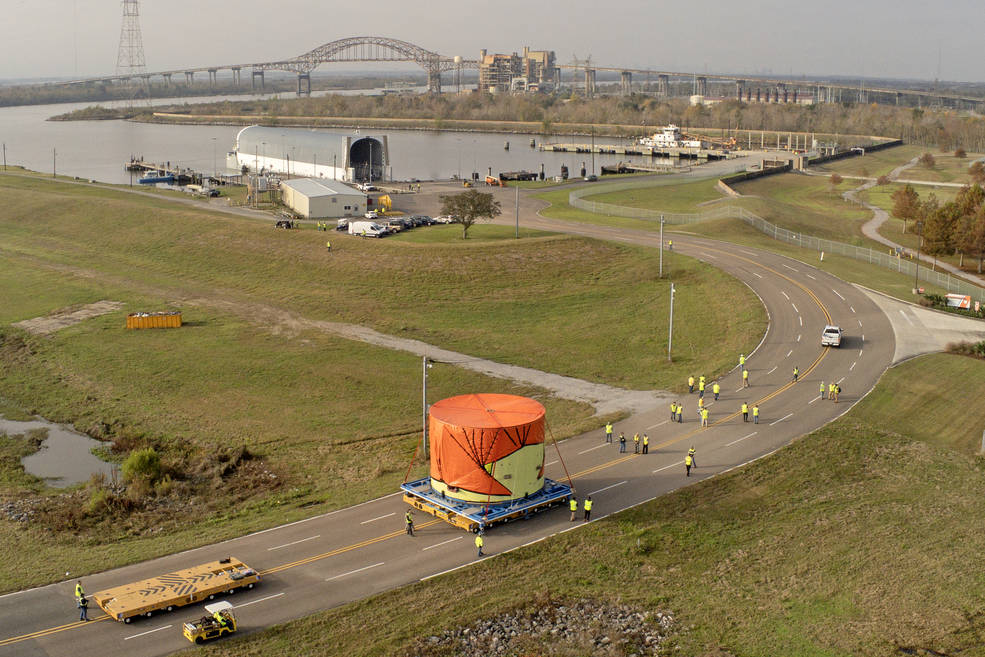NASA is moving forward with Space Launch System (SLS) production and assembly activities for future Artemis missions.
The agency is optimizing manufacturing capabilities by enabling SLS core stage lead contractor Boeing to use facilities at NASA’s Kennedy Space Center in Florida to perform some core stage assembly and outfitting activities beginning with the Artemis III rocket. In tandem, teams will continue all core stage manufacturing activities at NASA’s Michoud Assembly Facility in New Orleans.

As the SLS program transitions from rocket development efforts to operations, NASA and Boeing evaluated how to improve upon the time required to produce each core stage and best use space at Michoud.
“We’re making progress developing, manufacturing, and assembling elements for future Artemis missions,” said Jim Free, associate administrator for the Exploration Systems Development Mission Directorate. “Our collective workforce across NASA centers and industry partners plays a key role in accomplishing NASA’s long-term plans for exploring the Moon.”
Beginning with production for Artemis III, NASA and Boeing will use Michoud, where the SLS core stages are currently manufactured, to produce and outfit the core stage elements, and available space at Kennedy for final assembly and integration. This opportunity provides for multiple mission elements to be manufactured and outfitted at the same time and for the workforce at Michoud to begin building the rocket’s exploration upper stage, which will enable SLS to send even heavier and larger cargo to the Moon on the same missions with astronauts beginning with Artemis IV.
All five major core stage structures will be manufactured at Michoud using current robotic welding tools and fixtures and complete all thermal protection system spray applications at Michoud. There, the forward skirt, the intertank, liquid oxygen tank, and the liquid hydrogen will continue to be outfitted and joined to form the upper part of the core stage. Upon completion, these structures, which comprise the top four-fifths of the 212-foot-tall stage, will be shipped to Kennedy’s Vehicle Assembly Building (VAB) where they will be joined and vertically integrated in High Bay 2.
Once the engine section structure is manufactured, it will be transported to Kennedy’s Space Station Processing Facility for outfitting in the facility. When the engine section is completely outfitted, it and the stage’s four RS-25 engines will be moved to the VAB’s High Bay 2 for integration with the rest of the core stage, where technicians can more easily move it for stacking and assembly operations.
Four of five major core stage parts for Artemis II have been joined, and teams are outfitting the last part, the engine section, and will soon connect it and the RS-25 engines to complete the stage at Michoud. The Artemis II stage is scheduled to be completed and delivered to Kennedy in 2023. The engine section for the Artemis III SLS core stage is expected to arrive at Kennedy in mid-December.
With Artemis, NASA will land the first woman and the first person of color on the lunar surface and establish long-term exploration at the Moon in preparation for human missions to Mars. SLS and NASA’s Orion spacecraft, along with the commercial human landing system and the Gateway in orbit around the Moon, are NASA’s backbone for deep space exploration.
Rachel Kraft
Headquarters, Washington
202-358-1100
rachel.h.kraft@nasa.gov
Corinne Edmiston
Marshall Space Flight Center, Huntsville, Ala.
256-975-6798
corinne.m.edmiston@nasa.gov























